THE GLORY DAYS, PART II.
 Monday, July 24, 2017 at 08:22AM
Monday, July 24, 2017 at 08:22AM Editor's Note: Peter is taking a much-needed summer break from writing "Fumes," although he will write a new column if news from the sport dictates as such, and we will continue our weekly racing updates in "The Line." But as a bonus, we're going to be re-running Peter's riveting series, "The Glory Days," in its entirety over the next several weeks. The inside story of Tony DeLorenzo's racing career (Peter's brother), one of the most successful Corvette racers of all time - including the fantastic exploits of the famous Owens/Corning Fiberglas Racing Team - was one of the most widely read and popular pieces ever to appear in Autoextremist.com. So enjoy, because it was a different time and a different era, one never to be repeated. -WG
By Peter M. DeLorenzo
© 2017 Autoextremist.com
Detroit. Last week, I recounted the very early beginnings of my brother Tony's racing career in "The Glory Days, Part I." He had progressed from an SCCA Driver's School at Watkins Glen, New York, in 1964, to racing a '65 Corvair in SCCA "A Sedan" to racing one of 20 L88 big block Corvettes built for 1967 in SCCA "A Production." From there, things picked up speed at an incredible pace. After a successful campaign over the summer of '67, Tony qualified for the SCCA Runoffs, which were held at Daytona International Speedway that year. Tony qualified third among a pack of 427 Shelby Cobras driven by (pole-sitter) Ed Lowther, Dick Smith and Jack Hurt. Smith would win that day with Tony coming in second, followed by Lowther and Hurt. It was also the first time people in the racing world started to hear about Tony, as his Daytona exploits were featured in the quarterly publication, Corvette News (now Corvette Quarterly).
That summer was significant, too, in that Tony and Jerry Thompson, a Chevrolet engineer and accomplished Yenko Stinger Corvair racer (he won the SCCA National Championship in "D Production" in '67) developed a friendship and ultimately a partnership that would blossom into one of the greatest Corvette racing teams of all time. Tony and Jerry actually tried co-driving in a race together for the first time at Watkins Glen, New York, in The Glen 500 in '67. Things didn't go to plan - as often happens in racing - when the engine blew on Saturday morning. Tony’s best friend and volunteer crewman (everyone was a volunteer in those days) Greg Obloy called his uncle back in Detroit and they took his van over to his parent’s house to collect the spare L88 that was sitting in the garage, still in the crate. They drove all night and arrived at The Glen early Sunday morning and one of the all-time monumental thrashes began. They got the job done although there was some drama shortly before the race started when Tony’s friend, Al Kinzer, was asked to jack up the car so a new set of rear tires could be installed. As Tony remembers, "Al was unfamiliar with the jack point and used the sheet metal cooling scoop on the rear axle as the pad. Oops!!! Hammers and flailing got it straightened out before the green flag flew. We finished the race and a good time was had by all at the end of the day. Al and I still laugh about the jacking episode to this day!"
But it was at the end of the '67 season that everything changed. More SCCA racing was on the agenda for 1968, of course, but the "big" races were beckoning - the endurance races at Daytona, Sebring and Watkins Glen. How could we do it? There was a lot to it, of course, because it wasn't just the money; the support crew of volunteers would have to be enhanced too. That's where Jerry came in. As anyone who has lived in this town knows, all of the manufacturers' engineering and design staffs are hotbeds of hard-core enthusiasts. And back then, that was definitely the case. Jerry had a network of friends at Chevrolet Engineering who were skilled in specific disciplines such as brakes, suspension, engines and electrical; and it was not uncommon for them to show up at Jerry's garage - where we were temporarily keeping the car - and pitch in to help.
But racing at the Daytona 24 Hour race in 1968 was daunting, because some things had to come into place and we weren't sure how it was going to happen. I'll let Tony tell it: "Jerry had gotten to know Don Yenko through his racing the Yenko Stinger Corvair. That helped get us the invite to join the Sunray DX Corvette team at the ’68 Daytona 24 Hr. There was only one major problem – we didn’t have a car. Hanley Dawson had tried to order a new L88 and was told they were all “spoken for." Ironically enough, Yenko Chevrolet got one and Dick Guldstrand had gotten three." (Why did Guldstrand get three you might ask? Well, because Guldstrand's team was backed by actor Jim Garner, the higher visibility play for Chevrolet.)
Given that we were out of options, "Hanley finally agreed to let us build a car out of parts," Tony recalled. "Kids, don't try this at home! We built it in Jerry’s garage and PMD can tell you how many trips he made to the Chevrolet Otterburn parts warehouse near Flint to pick up pieces that were needed (I try not to remember. -PMD). We got the car done although the finish work was completed in the garage at Daytona Speedway, which was not uncommon back then. We broke about everything you could break but we still finished the race." A list of the parts chewed up during that grueling race? A steering relay rod failed (during night practice with Tony at the wheel), which caused the front wheels to point in different directions entering Turn 1. Not Good. "I just headed for NASCAR turn 2," Tony recalled. That's not all. There were front hubs and spindles; driveshafts; rear hubs; and rear axles. "We started borrowing parts from the Guldstrand/Garner team to survive," Tony remembers. "And at around 2:00 a.m. Jim Garner visited our pit to say 'hi' and the guys started edging toward the hammers. Remember, racing is war, and even though we were allegedly on the same team, we really weren't. Then Jim flashed the 'Rockford smile' and said he just came over to see how his parts were doing. Instantly, he was the crew’s new best friend." Dave Morgan and Jerry Grant went on to win the GT +2.5L class for the Sunray DX team, finishing 10th overall.
So there we were. We had survived our first two major endurance races (we also ran at the 12 Hours of Sebring in Sunray DX colors) and now we had two cars: the just-completed '68 427 L88, and the '67 427 L88. It was decided over beers one night - as all good racing decisions are made - that we would re-paint the '68 back to the preferred DeLorenzo Black and Tony would run it in "A Production" for the '68 SCCA season. Then we would pull the L88 out of the '67 and put a small black in it so that Jerry could race it in "B Production." The other big news? We had finally graduated from working out of various household garages to a long and low garage that sat behind a house on 16-Mile Rd. in Troy, Michigan, a northern suburb of Detroit. It was the perfect space; it held as many as eight cars, giving us room to work on multiple cars at once; and even room for painting and body work. Now? It's long forgotten as development swallowed the land up whole decades ago, but back then that unassuming garage became famous for being the headquarters for America's baddest-ass Corvette racing team.
1968 would soon prove to be the pivotal year. Tony and Jerry started kicking ass in their respective classes in SCCA competition, but new opportunities were just around the corner. Dollie Cole's friend at Owens/Corning Fiberglas - Loris Norstad - who was an EVP in their New York office, bought into Dollie's idea that sponsoring our Corvette racing team would be good for OCF's OEM business in Detroit. (See "The Glory Days, Part I"). It was. The sponsorship and marketing deal began in August, with Tony delivering a SCCA National win the first time out at Mid-Ohio, OCF's "home" track. We were off and running.
It should be noted here that the bold graphics package and presentation of the OCF cars was real breakthrough stuff at the time. Remember, prior to 1968, the SCCA employed rules prohibiting overt sponsorship graphics. For 1968, that arcane rule was lifted. This was also the year that Colin Chapman showed up at Monaco with his famed Lotus F1 cars painted in Gold Leaf tobacco colors instead of their classic British Racing Green livery; the sponsorship era in motor racing had well and truly begun. The SCCA - seeing the winds of change in international racing - decided to be on the side of history, it appears.
But there was more to the graphics package on the OCF cars than meets the eye. Another of our "volunteers" was none other than Randy Wittine, the famed GM Design star who would eventually develop some of the most iconic paint and graphic schemes not only for our team, but eventually for Roger Penske and others. Randy was flat-out brilliant, and his work was known far and wide in the racing world. A funny aside? Randy would work on the cars on weekends always in a white, long-sleeved, buttoned down dress shirt. He would then take it to the cleaners on Monday, repeating the process week, after week, after week. Two years into this, and Randy's work shirt would come back from the cleaners basically in shreds, still pressed and cleaned and mounted on cardboard, but deteriorating before our very eyes. It was his signature thing.
How our team "delivered" for Owens/Corning Fiberglas didn't stop with the graphics on the cars; or the superb PR work performed by OCF's Roger Holliday; or the team's crew uniforms; or the appearances by Tony and Jerry on behalf of OCF (with Tony using the his PR background to great effect). There was also the little matter - actually a large matter - of the 45' tractor trailer rig emblazoned with "Owens/Corning Fiberglas Corvette Racing Team" graphics for all to see. It changed the playing field in promotional activation in racing at the time, and led the way for all other teams to follow. Everyone, and I mean everyone assumed we were dripping with money, with the impact of the big rig only adding to the suspicions. But they were wrong. They had no way to know that over the entire course of the program the famed Owen/Corning Fiberglas Corvette Racing Team was predominantly an all-volunteer operation. Some gifted and brilliant volunteers to be sure, but in reality it was, for the most part, a truly all-volunteer operation.
And how that big rig came about is part of the lore associated with the team. An old, close friend of our father, a gentleman by the name of Bert Beveridge, owned a trucking company that picked up cars at the manufacturer assembly facilities and delivered them to dealers all over the country. Yes, ol' Bert did very well. When talking with Tony one day, Bert heard that we really needed to figure out a better way to transport the cars to the races, as the individual truck/trailer arrangement had grown very old. On the spot Bert offered to sell us a very used 45' trailer for $100. We found a place that would refurbish it and paint the graphics - designed by Randy Wittine, of course - and we found a deal on a highly used tractor, and at the end of the day I think we had $5,000 in the whole thing. But the impact when showing up at the races? Priceless. Another aside? Bert's grandson is a gentleman by the name of Tito Beveridge. Sound familiar? Yes, of Tito's Vodka fame.
From then on it was about the racing, pure and simple. The two black cars gave way to two "A Production" cars resplendent in OCF colors as the team barnstormed its way across the country winning SCCA National races almost at will, and of course triumphing in the premier U.S. endurance road races at Daytona, Sebring and Watkins Glen over a glorious three-year run, reestablishing the Corvette as a force to be reckoned with in major league sports car racing.
We had fun. And we made history.
Stay tuned for Part III.
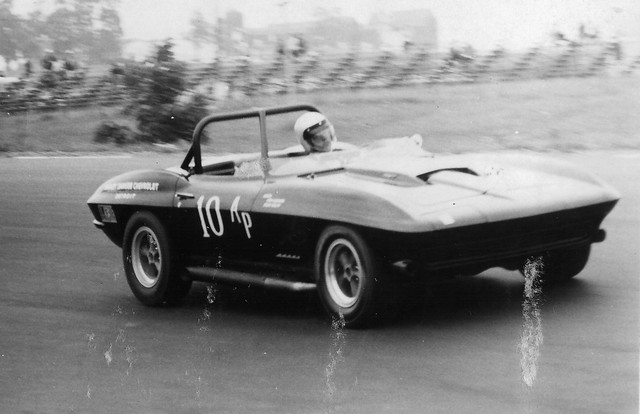
(The DeLorenzo Collection)
"The Glen 500" at Watkins Glen in 1967. This was the first race for Tony DeLorenzo and Jerry Thompson as a duo in the '67 L88 Corvette.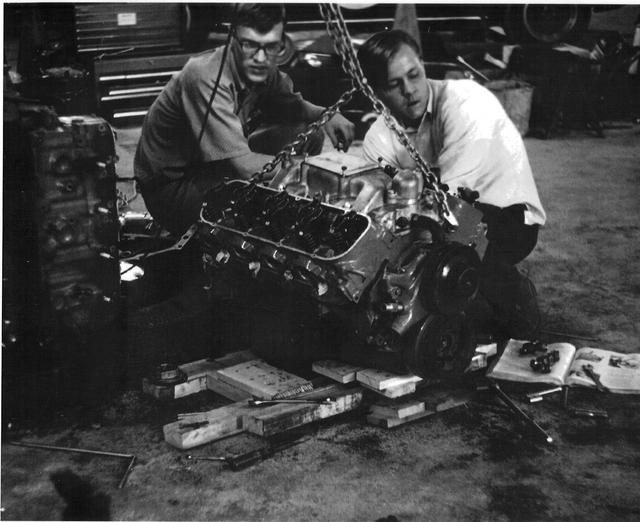 (The DeLorenzo Collection)
(The DeLorenzo Collection)
The "Monumental Thrash" to get the the new L88 installed Sunday morning before the start of the "The Glen 500" in '67; with Chris Cooper (left) and Tony's best friend Greg Obloy in mid-thrash. Note the remnants of the engine crate still underneath it.
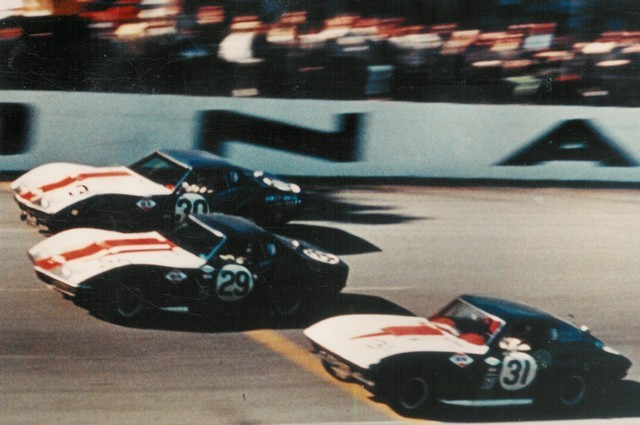
(The DeLorenzo Collection)
The first time at a major endurance race for DeLorenzo and Co. was the Daytona 24 Hour race in 1968 as part of the Sunray DX team. Dave Morgan/Jerry Grant (No. 31 Sunray DX/1967 Chevrolet Corvette 427 L88); Don Yenko/Peter Revson (No. 29 Sunray DX/1968 Chevrolet Corvette 427 L88); and Tony DeLorenzo/Jerry Thompson (No. 30 Hanley Dawson Chevrolet/Sunray DX/1968 Chevrolet Corvette 427 L88) fly in formation on the banking. The DeLorenzo Corvette team would run one more race as part of the Sunray DX Team that year: At the 12 Hours of Sebring.
 (The DeLorenzo Collection)
(The DeLorenzo Collection)
Dollie and Ed Cole. He was the brilliant engineering genius and true enthusiast who was one of the creators of the small block Chevrolet V8 and who led GM Product Development in its heyday. Ed is a true icon of the industry. She was his radiant wife, a fierce defender of all things Ed and a fiery enthusiast in her own right. She tooled around Bloomfield Hills and Birmingham - two northern suburbs of Detroit - in her '65 Nassau Blue Corvette 4-speed roadster with a blue interior, a removable hard top and side pipes. She famously dubbed it her "Bluebird." Ed stuffed a big-block 396 V8 in it a year before the engines were released to the public. She let Tony borrow it on several occasions.
 (Photo by Roger Holliday/The DeLorenzo Collection)
(Photo by Roger Holliday/The DeLorenzo Collection)
This was the official photo that went out with the press release announcing the Owen/Corning Fiberglas Corvette Racing Team. Note the stunning paint job design - stressing paint job, no "wraps" back then - by Randy Wittine, which included silver, along with the OCF orange and white. The Silver would go away for the '69 season.
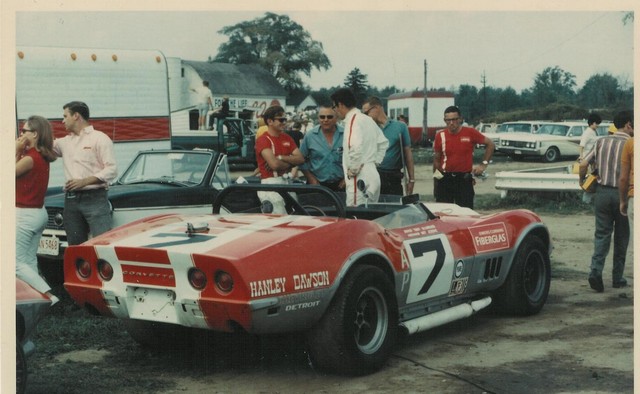 (The DeLorenzo Collection)
(The DeLorenzo Collection)
The second race for the brand new OCF team was at Nelson Ledges, in Warren, Ohio. Leslie Kothe and Randy Wittine are standing by the left rear of the No. 7 car. Chief Mechanic Art Jerome and Jerry Thompson are talking with Don Yenko’s crew chief at the front of car, and Rollie Aiken - one of the volunteer gang and Jerry's good friend - is on the right in the red t-shirt.
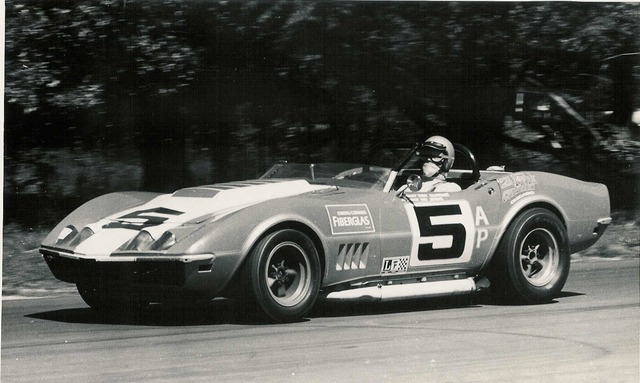
(Photo by Roger Holliday/The DeLorenzo Collection)
Another early national race for the new OCF team in '68, this time at Blackhawk Farms, in Illinois. Note the “Z-Frank Chevrolet” tag on the rear fender. "Z-Frank Chevrolet" was a huge dealer in the Chicago area and Hanley Dawson, Jr. helped get some additional sponsorship for the team in what was a one-race deal. The result? Another win in "A Production".
 (Photo by Roger Holliday/The DeLorenzo Collection)
(Photo by Roger Holliday/The DeLorenzo Collection)
The Owens/Corning Corvette Racing Team made its official international racing debut at Daytona for the 24 Hour race in 1969, entering two cars (No. 66 and No. 67) for the race. Here, Tony visits with GM Design legend Bill Mitchell - our neighbor back home - on the starting grid before the start of the race. The race itself was a debacle for the team (see below).
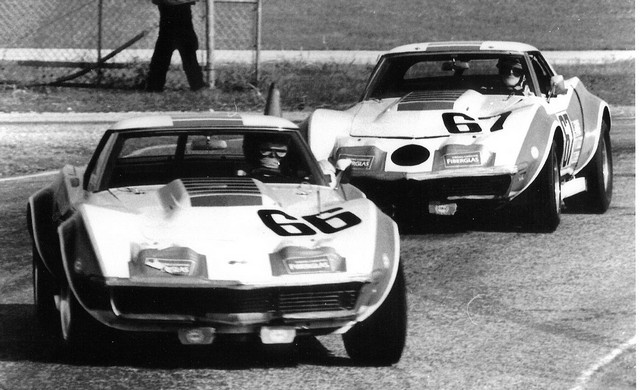
(Photo by Hal Crocker/The DeLorenzo Collection)
Tony DeLorenzo leads Jerry Thompson early in the 1969 Daytona 24 Hour race.
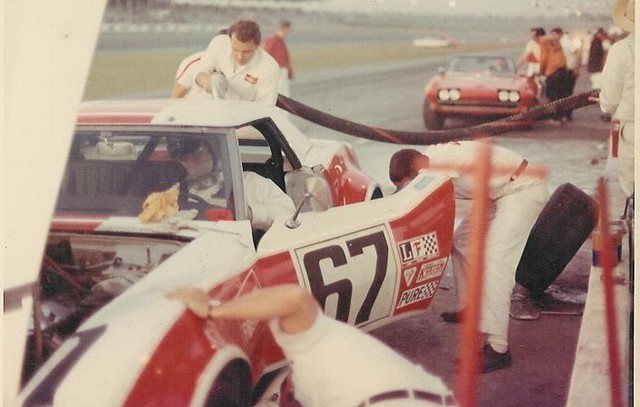 (Photo by Roger Holliday/The DeLorenzo Collection)
(Photo by Roger Holliday/The DeLorenzo Collection)
Tony was in the No. 66 Corvette when a RR tire blew early in the race at Daytona, which knocked the fuel pump filter bowl off causing a full-fledged fire as he entered the pits. Crew chief Art Jerome made the decision to retire the car on the spot. That wasn't the end of Tony's adventure that year at Daytona. Here he's seen buckling into the No. 67 car (above, with Randy Wittine re-fueling, Rollie Aiken checking the LR tire, while Fred Mckenna checks the LF) and as he tells it: "At around midnight I was driving the No. 67 car and the RF tire blew in the NASCAR Turn 4 banking. I hit the wall parallel, and the impact was hard enough to knock my hands and feet off the controls. I was temporarily stunned, but I recovered enough to get the car stopped up against the wall. As I was figuring out a plan - right - to exit, a Camaro in the act of passing a couple of 911 Porsches blew by me at maybe 160 mph. I learned 20 years later that the gap between him and me was maybe an inch!!! The concussion scared the crap out of me so I unbuckled and slid out the window on to the roof. I grabbed the 31-degree angled fence and climbed to the top. I might have fallen off but I don’t remember exactly how I got down. I just remember them picking me up and sending me to the infield care center. I was deemed to be okay and they released me. The race car? Not so much, it was a total loss. It had two broken fender flares and a black streak down the right side from scraping along the wall; the RF and RR suspension were crushed; the front frame cross member was bent about 6” (!); both engine mounts and the transmission mount were broken; and the rear axle was broken. We went back home and fixed it with a completely new frame and all new parts, etc., etc." (Sounds of Corvette classic enthusiasts throwing hats on ground and jumping up and down on them!)
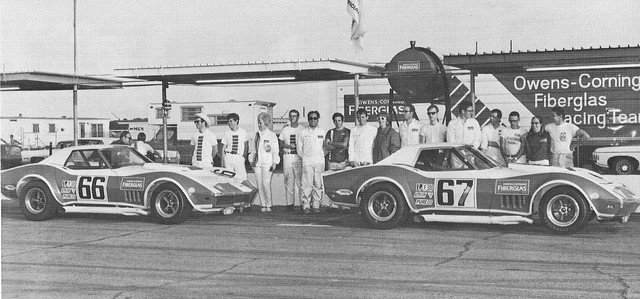
(Photo by Roger Holliday/The DeLorenzo Collection)
The Owens/Corning Corvette Racing Team gather for an official photo before the start of the Daytona 24 Hour race in 1969. You can catch a glimpse of the OCF Corvette Racing Team trailer in the background. (The DeLorenzo Collection)
(The DeLorenzo Collection)
A close-up of the Dymo labels on the steering wheel hub of Tony's car at Daytona, in '69. The initials say “WOP – DFU.” I'm sure you can figure out what they stand for! (Photo by Roger Holliday/The DeLorenzo Collection)
(Photo by Roger Holliday/The DeLorenzo Collection)
After the debacle at Daytona in 1969, the team gained a measure of redemption at Sebring six weeks later. Here Jerry and the crew celebrate finishing the 12 Hours. (L to R): Jerry Thompson; Steve Hendricks; Rollie Aiken; Crew Chief Art Jerome; Chris Cooper (behind Art); Harry Lambert; Randy Wittine; and Les Talcott. Beer!!! 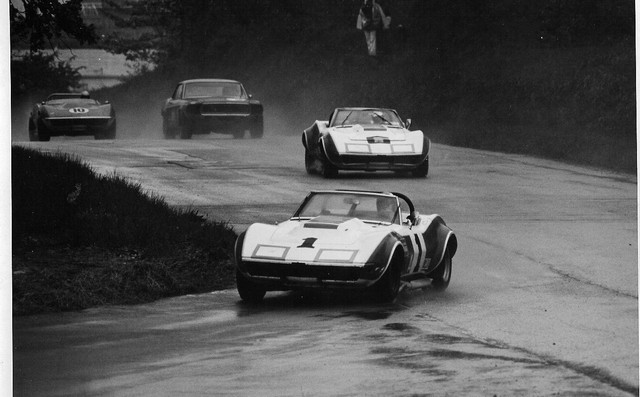 (The DeLorenzo Collection)
(The DeLorenzo Collection)
Carpentersville, Illinois, May, 1969. Tony (No. 1) leads Jerry (No. 6) to a 1-2 finish in the pouring rain at Meadowdale Raceway. Note the skinny rain tires tucked inside the fender flares. Note also the full windshields. The decision was made to leave the full windscreens on because there was another endurance race coming up at Watkins Glen. Two significant things about this weekend? It marked the start of "The Streak" for the Owens/Corning Fiberglas Corvette Racing Team. The OCF boys won 22 straight National races, with fourteen of them 1-2 finishes. It was also the final race ever held at the famed Meadowdale Raceway. (Photo by Roger Holliday/The DeLorenzo Collection)
(Photo by Roger Holliday/The DeLorenzo Collection)
Elkhart Lake, Wisconsin, June 1969. Tony leads Jerry on the pit straight at Road America during the June Sprints National race weekend, and to another 1-2 sweep in "A Production".
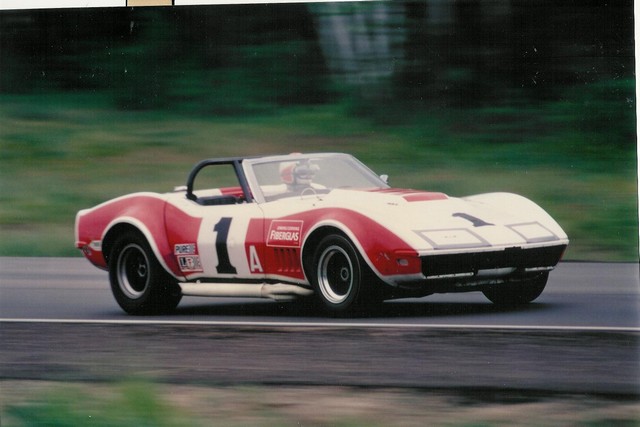
(The DeLorenzo Collection)
Tony at speed at the Donnybrook circuit in Brainerd, Minnesota, in 1969. Another 1st in "A Production" right before going back to The Glen for the 6-Hour FIA race.
(The DeLorenzo Collection)
Watkins Glen, New York, July, 1969. It finally started to come together for the OCF Corvette Racing Team in international endurance racing. Tony (above) and Dick Lang (No. 14 Owens/Corning Fiberglas Chevrolet Corvette 427 L88) finished 1st in GT and seventh overall in The Glen 6-Hour race. The No. 15 team car driven by Jerry Thompson and Bill Morrison recorded a DNF due to an accident.
Editor's Note: Many of you have seen Peter's references over the years to the Hydrogen Electric Racing Federation (HERF), which he launched in 2007. For those of you who weren't following AE at the time, you can read two of HERF's press releases here and here. And for even more details (including a link to Peter's announcement speech), check out the HERF entry on Wikipedia here. -WG
Publisher's Note: As part of our continuing series celebrating the "Glory Days" of racing, we're proud to present another noteworthy image from the Ford Racing Archives. - PMD
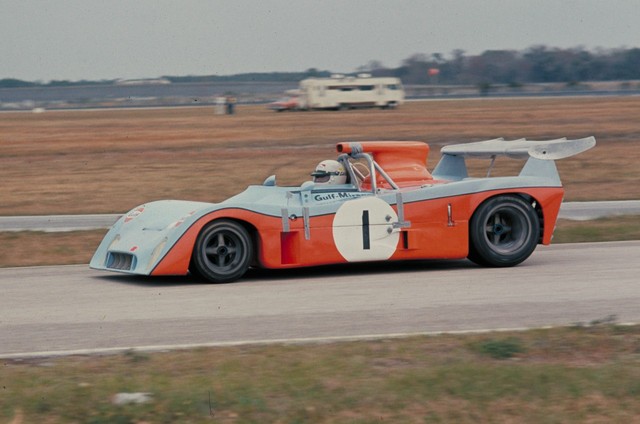
(Courtesy of the Ford Racing Archives)
Daytona Beach, Florida, February 4, 1973. The Derek Bell/Howden Ganley (No. 1 Gulf Racing Mirage M6 Ford Cosworth DFV) at speed in that year's Daytona 24 Hour race. Part of a two-car entry, with the No. 2 team car driven by Mike Hailwood and John Watson, neither car would finish the race. The race was won by Peter Gregg and Hurley Haywood driving the No. 59 Brumos Porsche 911 Carrera RSR. François Migault/Milt Minter (No. 22 North American Racing Team Ferrari 365 GTB) were second, and Dave Heinz/Bob McClure/Dana English (No. 5 Chevrolet Corvette 427 L88) finished third. The No. 11 Troy Promotions Budd Corvette driven by Tony DeLorenzo and Maurice ("Mo") Carter qualified 1st in GT and sixth overall, but would suffer a DNF.





